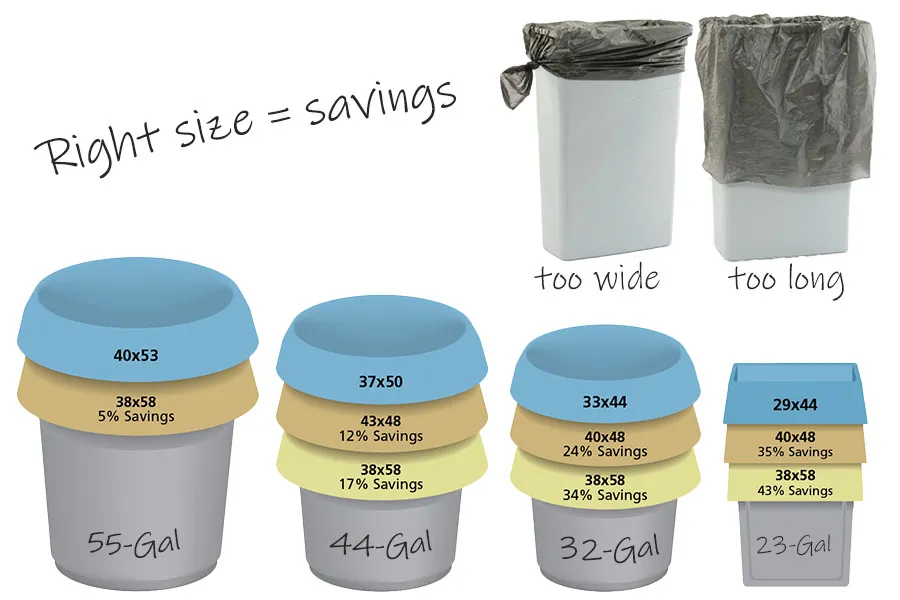
Trash liners are a small detail, but one that adds up across hundreds of rooms and bins.
Introduction: Why Trash Liners Deserve More Attention Than You Think
Trash liners aren’t the most glamorous line item in your housekeeping budget. But for hotels, restaurants, and facilities where waste never stops moving, the wrong bag can quietly drain dollars and labor.
Too thin, and bags rip—forcing staff to double-bag, clean spills, and lose time. Too thick, and you’re overspending on plastic you don’t actually need. Multiply that across dozens of bins, hundreds of rooms, and 365 days a year, and you can see how trash liners become a real cost-control lever.
This guide breaks down liners by the numbers—gallons, mils, and smart fit—so you can balance durability with cost efficiency.
Gallons: Sizing Your Liners the Right Way
Every trash can has a sweet spot. Choose too small of a liner and you’ll constantly fight “bag slip,” where the liner caves into the can. Too large, and you’re literally throwing away money as plastic bunches around the rim.
A few quick sizing rules of thumb:
- Rectangular cans → Add the perimeter of the can (all sides), divide by two for width. Then take the height, add half the width, and add 3 inches for overhang.
- Round cans → Take the diameter × 3.14, divide by 2 for width. Then add the height + half the diameter + 3 inches for overhang.
Getting this right not only saves money but also reduces frustration for housekeeping staff who are bagging and re-bagging all day.
Mils and Microns: Understanding Thickness
If gallons are about fit, mils are about strength.
- Mil = one-thousandth of an inch. A 2-mil bag is twice as thick as a 1-mil.
- Micron = one-millionth of a meter. Often used internationally. For quick conversion, 1 mil ≈ 25 microns.
The trick is matching thickness to the type of trash:
- Light liners (0.35–0.50 mil / 9–12 micron) → Ideal for office waste like paper and wrappers.
- Medium (0.70–0.90 mil / 17–22 micron) → Small kitchen bins with light food waste, cans, or folders.
- Heavy (1–2 mil / 25–50 micron) → Food service, warehouse, or housekeeping areas with wet or sharp refuse.
- Extra-heavy (2+ mil / 50+ micron) → Industrial kitchens, banquet trash, sharp debris, or outdoor cans.
Choosing liners by thickness rather than just price helps you avoid the hidden costs of double-bagging or staff time lost on cleanups.
Cost Control: The Overlooked Saving Opportunity
Think of liners like a recurring subscription—you’re buying them every week, every month, across every department. That’s why small inefficiencies snowball.
A few strategies to trim costs without sacrificing performance:
- Match fit exactly. More than 3–4 inches of overhang is wasted plastic.
- Stop double-bagging. If staff is doubling up, you’re using the wrong strength. Upgrade thickness slightly instead—it’s cheaper than doubling volume.
- Pick liner material wisely.
- LLDPE (low-density): flexible, good puncture resistance, best for irregular waste.
- HDPE (high-density): thinner, less stretch but excellent chemical resistance and odor control—ideal for bathrooms or food service.
- Standardize purchasing. Choose 2–3 “core liners” that cover 80% of your needs. Fewer SKUs = bulk buying = lower cost.
Facilities that review their liner program often find 10–20% savings simply by adjusting sizes and materials.

Every bit helps - pick the right sized liner! Source: Hillyard Source: Hillyard
Closing Thoughts: Small Bags, Big Impact
Trash liners may be the least glamorous part of your operation, but they punch well above their weight in cost control. Get the right fit, the right thickness, and the right material—and you’ll cut waste in more ways than one.
👉 Ready to take it further? Check out our downloadable Liner Cheat Sheet for quick reference—or grab a set of recommended commercial liners from our Amazon picks.
Frequently Asked Questions
How do I match bag size to my bins?
Use the bin’s circumference and height to choose gallons and dimensions; the right fit prevents tears and time-wasting double-bagging.
What do ‘mils’ and ‘microns’ mean?
They indicate thickness. Heavier liners (higher mils/microns) resist punctures in housekeeping/maintenance areas; lighter bags fit low-risk bins.
Are recycled-content liners strong enough?
Modern recycled liners can handle most hotel use—pick thickness by area (e.g., heavier for back-of-house, lighter for guestroom baskets).
Where does cost control actually come from?
Correct sizing, fewer splits, and standardizing SKUs so you can buy in cases—less waste and less time spent swapping liners.